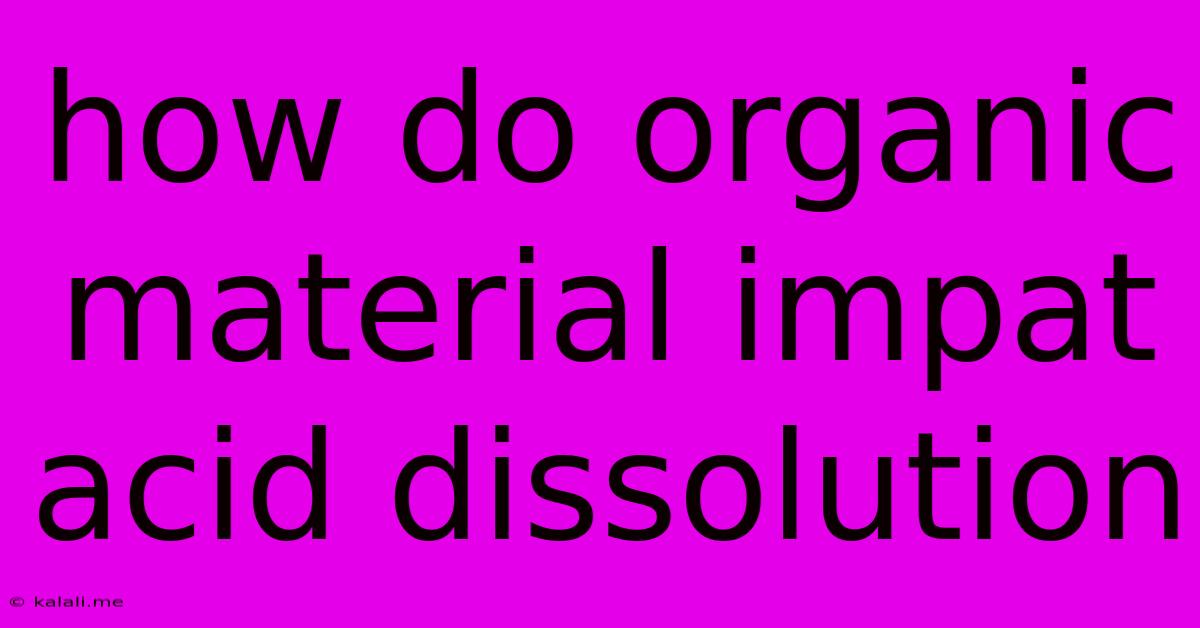How Do Organic Material Impat Acid Dissolution
Kalali
May 23, 2025 · 3 min read

Table of Contents
How Organic Materials Impact Acid Dissolution
Meta Description: Discover how organic materials influence acid dissolution processes. This article explores the complex interactions, including complexation, adsorption, and the formation of protective layers, affecting dissolution rates and efficiency. Learn about the practical implications across various industries.
Acid dissolution, the process of dissolving a material using an acidic solution, is a crucial step in numerous industrial processes, from metal extraction to waste treatment. However, the presence of organic materials can significantly alter the dynamics of this process, often complicating it and influencing the overall efficiency. Understanding these impacts is critical for optimizing industrial processes and predicting environmental behavior.
Complexation: A Key Interaction
One of the most significant ways organic materials affect acid dissolution is through complexation. Organic molecules, often containing functional groups like carboxylates, amines, or hydroxyls, can form complexes with metal ions released during dissolution. This complexation can have two primary effects:
-
Increased Dissolution: Some organic ligands can enhance dissolution by forming soluble complexes with the metal ions, effectively removing them from the solid surface and driving further dissolution. This is particularly relevant in the extraction of certain metals from ores. The stability constant of the formed complex plays a vital role in determining the impact.
-
Decreased Dissolution: Conversely, other organic ligands can form stable, insoluble complexes, effectively hindering the dissolution process. This "passivation" can create a protective layer on the material's surface, dramatically reducing the rate of acid attack.
Adsorption: Blocking the Acid's Access
Adsorption of organic molecules onto the mineral surface is another crucial mechanism. Organic molecules can physically block the active sites on the mineral surface, preventing the acid from reaching and reacting with the mineral. This physical barrier can significantly reduce the overall dissolution rate. The extent of adsorption depends on factors like the concentration of the organic molecules, the pH of the solution, and the surface properties of the mineral.
Formation of Protective Layers: A Physical Shield
The interaction between organic materials and acid dissolution can lead to the formation of protective layers on the mineral surface. These layers can be composed of the adsorbed organic molecules themselves, insoluble metal-organic complexes, or even precipitates formed due to the altered solution chemistry. These layers act as physical barriers, slowing down or completely stopping the acid dissolution process. This is a common phenomenon observed in the corrosion of metals in the presence of organic inhibitors.
Practical Implications Across Industries
The impact of organic materials on acid dissolution has significant implications across various industries:
-
Mining and Metallurgy: Understanding the influence of organic matter in ores is crucial for optimizing the extraction of valuable metals. The presence of organic compounds can impact leaching efficiency and require adjustments to the acid concentration or the addition of complexing agents.
-
Waste Management: The presence of organic materials in waste streams can affect the effectiveness of acid-based treatment processes. This is particularly relevant in the treatment of hazardous waste containing heavy metals.
-
Environmental Science: The role of organic matter in soil and sediment systems influences the release and mobility of metals in the environment. Understanding these interactions is essential for assessing environmental risks and developing effective remediation strategies.
Further Research and Considerations
The interaction between organic materials and acid dissolution is a complex process governed by a variety of factors. Further research is needed to fully understand the interplay of these factors and develop predictive models for different systems. This includes exploring the impact of specific functional groups, the influence of solution chemistry, and the role of environmental parameters such as temperature and pressure. This knowledge is crucial for improving the efficiency of industrial processes and for predicting the fate of materials in the environment.
Latest Posts
Latest Posts
-
Wordpress Custom Post Type Attachment Not Showing Parent
May 23, 2025
-
Why Is Mirror Overlaping In Blender
May 23, 2025
-
Wordpress Attachment Does Not Have Parent
May 23, 2025
-
Lyx How To Define A Definition
May 23, 2025
-
How To Remove Dried Latex Paint
May 23, 2025
Related Post
Thank you for visiting our website which covers about How Do Organic Material Impat Acid Dissolution . We hope the information provided has been useful to you. Feel free to contact us if you have any questions or need further assistance. See you next time and don't miss to bookmark.